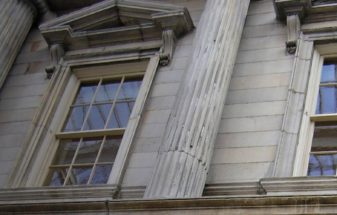Is Your Glass Safe (Kid & Pet-Friendly)?
Types of Safety Glass, Where & Why You Might Need Them
However you incorporate glass into your home or office – from a small remodeling project to designing a new space – you can benefit from understanding what safety glass is and why and where it may be required.
While safety glass has many added benefits, it is primarily designed to resist breaking and, if it does break, to minimize the risk of injuries. Safety glass is available in tempered and laminated forms.
Tempered glass is approximately four times stronger than regular annealed (non-safety) glass of the same thickness. To temper glass, Bendheim first cuts it to size and fabricates all required holes and notches, such as the ones for hardware. Then, the glass edges are polished, if desired. The glass is transferred to a tempering furnace, heated to a precise softening point, and rapidly air-cooled. The resulting heat-treated / tempered glass breaks into small, relatively harmless dice-size pieces, greatly reducing the likelihood of a major injury.
Laminated glass is a combination of two or more glass sheets with one or more interlayers of plastic (PVB) or resin. In the case of breakage, the interlayer holds the glass fragments together, and its high strength prevents the glass from breaking into large sharp pieces. Laminated safety glass offers superior safety, security and sound transmission control. It prevents pass-through of objects and provides increased protection against fall-out and penetration of the opening.
Homeowners should consult their local building codes regarding the required use of safety glass, as they are constantly changing and can vary by state, county, city, town or borough. If you are working on a home construction project, make sure to contact your local building inspection department, office of planning and zoning, and department of permits to learn which codes are applicable in your area.
As a general rule of thumb, Bendheim strongly recommends tempered or laminated glass for all applications where safety and security are desired including but not limited to:
- Glass doors and sidelites
- Glass enclosures
- Partitions
- Glass shelves
- Table tops
- Glass surrounding bathtubs, showers, hot tubs, and saunas
- All frameless glass installations
- Under counter cabinets in homes with small children and/or pets
Bendheim also recommends the use of tempered glass in installations subject to high temperatures, such as kitchen countertops and backsplashes, as well as in shower and tub enclosures, unless required otherwise by your building code. In all other cases, the application will determine the choice of safety glass. For example, select tempered glass for stronger glass shelves, table and counter tops. For doors and sidelights, balconies and stairs, laminated glass is often selected for its ability to remain in the opening when broken and its resistance to smash and grab burglaries.
If you have questions about a specific DIY project you are working on, please make sure to follow applicable building codes and regulations, and contact your local building department first. Then, please visit our Cabinet Glass website and select the right safety option for your glass – tempered or laminated – the majority of our decorative glasses are available in either form.
Good luck on your project, and stay safe!
Bendheim is one of the world’s foremost resources for specialty architectural glass. Founded in New York City in 1927, the fourth-generation, family-owned company offers a virtually unlimited range of in-stock and custom architectural glass varieties. Bendheim develops, fabricates, and distributes its products worldwide. The company maintains production facilities in New Jersey and an extensive showroom in New York City




